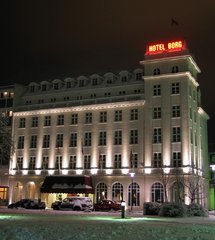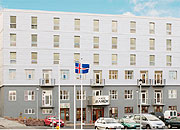Destination: |
ReykjavŪk, Iceland Hotels and City Guide
ReykjavŪk Hotels and ReykjavŪk Guide with ReykjavŪk maps, top attractions, room reservations and hotel deals at a wide range of the best ReykjavŪk hotelsReykjavŪk - Attractions
Reykjavík Attractions
Hallgrímskirkja
The tall, pale, volcano-shaped church in the centre of Reykjavík with views out to Faxaflói Bay from the steeple on a clear day.
The Pearl
This circular glass building on the top of Oskjuhl√≠√į Hill reflects the aurora borealis (Northern Lights) in winter.
Nauthólsvík Beach
Reykjavík's own beach, heated with geothermal water.
The Blue Lagoon
A 39¬įC bowl of milky-blue soup in the lava fields of the Reykjanes Peninsula with healing properties and an ethereal, otherworldly feel.
√ěingvellir National Park
Where you can see the earth being created in front of your eyes.
Lava by horseback
Get a feeling for the outback by trekking with one of the friendly Icelandic horses across the folklore-inspiring moonscape.
Landmannalaugar
A natural hot spring surrounded by multicoloured rhyolite mountains and fields of shiny obsidian.
Snæfellsjökull
This glacier was the inspiration for novels by Jules Verne and Halldór Laxness. There's plentiful birdlife and a few alien life forms out here too.
The Westman Islands
Home to thousands of puffins that leave in August, but outside the puffin season you can still see the odd whale or active volcano.
Geysir and Gullfoss
Much-visited natural wonders where you can see water leap high into the air, and a wide and beautiful two-step waterfall half-frozen in winter and veiled with rainbows and mist in summer.
At A Glance
Reykjavík is a small town by anyone's standards. Capital of a country the size of England and Wales together, the city comprises approximately 40% of the country's meagre population of 280,000, making it the island's only real city and the cultural centre of everything in Iceland. The attractions of coming here are twofold: for the countryside within easy reach of the city, alive with geological faults; and for the lifestyle in the city, young, vibrant and earth-shaking in its own way.
Laugardalur Valley and √Ėskjuhl√≠√į Hill
On the outskirts of the city you'll find two of Reykjav√≠k's most idiosyncratic sights. Laugardalur Valley is the centre of Iceland's sporting activity and a bit of a hotspot. The name refers to the hot springs, now used to feed the city's biggest swimming pool, with steam room, Olympic-sized outdoor pool and a number of hot pots. √Ėskjuhl√≠√į Hill has got the look of a secret military hideout built on the foundations of an old Second World War base, but the spherical Pearl building was not designed to be hidden, perched as it is like a broody hen, on top of six round tanks that store the city's hot water. It's the nearest thing the city has to the Eiffel Tower, with viewpoints out over the city and beyond, and a nice caf√© inside. At the very top there's a revolving gourmet restaurant and a fabulous bar, but both are prohibitively expensive even by Icelandic standards. Down at the foot of the hill you'll find a yellow- sand beach, hot pots and a warmed-up section of the Atlantic that you can swim or paddle in.
Hafnarfj√∂r√įur and the Blue Lagoon
On the Reykjanes Peninsula to the west of Reykjav√≠k are two sights that make use of the natural surroundings. The dark, bumpy, moss-covered lava fields around Hafnarfj√∂r√įur in particular have given rise to numerous stories about elves, pixies and angels, and a reputation for being home to the biggest otherworldly community in the country. And beyond it towards Keflav√≠k is the world-famous Blue Lagoon, a steaming pool of opaque turquoise water that leaches minerals from the lava bed, filling it with healing properties. Here you can lie back, put a mud pack on your face, relax and try not to let that whiff of sulphur put you off.
The Golden Circle: √ěingvellir, Gullfoss and Geysir
The Golden Circle is a day tour of three of Iceland's natural wonders, only about 50 km from the city. Passing through the small town of Mosfellsb√¶r you reach √ěingvellir, seated firmly on the Mid-Atlantic Ridge which swoops diagonally through the country, northeast from the capital. At √ěingvellir you can actually see the Eurasian and American continental plates draw apart from each other. From here you can get to Geysir, an area of spouting hot springs which gave its name to all such natural features the world over, and Gullfoss, a huge two-step waterfall that partially freezes in winter.
Akureyri, the Snæfellsnes Peninsula, Landmannlaugar and the Westman Isles
Beyond Reykjavík is a whole new world of lava fields, fjords and glaciers. Akureyri, the second largest city in the north of the country, is at the end of Iceland's longest fjord surrounded by a national park and provides the opportunity to reach the island of Grímsey on the Arctic Circle. The Snæfellsnes Peninsula, closer to Reykjavík, has an inspirational glacier, coastal walks and an impressive array of birdlife. Landmannalaugar in the central highlands is an area of outstanding beauty, with orange rhyolite mountains and a hot spring for outdoor bathing, as well as being the start point for one of Iceland's most spectacular hikes. Finally, the Westman Islands off the south coast have two volcanoes, walking trails and a host of puffin catchers in the summer months. The archipelago includes the island of Surtsey which emerged 40 years ago in a submarine volcano eruption.
101 Reykjavík
The bohemian old town of Reykjav√≠k is situated between two water features ‚Äď the harbour and the pond. In between the two you'll find the centrepoint of the city, Austurv√∂llur Square, with the historic Al√ěing parliament building and city cathedral, and some welcoming caf√©s on its borders. Follow the main street, Austurstr√¶ti, up the hill and it becomes Laugarvegur, the main shopping street. Above it on the hill is Hallgr√≠mskirkja, a towering church designed to look like an erupting volcano ‚Äď man, god and nature combined in almost frightening grandeur. Running quietly off Laugarvegur is Hverfisgata, a row of corrugated-iron houses in bright, primary colours with a lived-in appeal and wonderful views down to the water and beyond to Mount Esja. Down by the harbour you'll find the flea market at weekends with a fish hall at the back and, occasionally, fairground rides along the quayside, complete with children clutching those perennial favourites ‚Äď candyfloss, pylsur and dried cod.
Laugardalur Valley and √Ėskjuhl√≠√į Hill
On the outskirts of the city you'll find two of Reykjav√≠k's most idiosyncratic sights. Laugardalur Valley is the centre of Iceland's sporting activity and a bit of a hotspot. The name refers to the hot springs, now used to feed the city's biggest swimming pool, with steam room, Olympic-sized outdoor pool and a number of hot pots. √Ėskjuhl√≠√į Hill has got the look of a secret military hideout built on the foundations of an old Second World War base, but the spherical Pearl building was not designed to be hidden, perched as it is like a broody hen, on top of six round tanks that store the city's hot water. It's the nearest thing the city has to the Eiffel Tower, with viewpoints out over the city and beyond, and a nice caf√© inside. At the very top there's a revolving gourmet restaurant and a fabulous bar, but both are prohibitively expensive even by Icelandic standards. Down at the foot of the hill you'll find a yellow- sand beach, hot pots and a warmed-up section of the Atlantic that you can swim or paddle in.
Hafnarfj√∂r√įur and the Blue Lagoon
On the Reykjanes Peninsula to the west of Reykjav√≠k are two sights that make use of the natural surroundings. The dark, bumpy, moss-covered lava fields around Hafnarfj√∂r√įur in particular have given rise to numerous stories about elves, pixies and angels, and a reputation for being home to the biggest otherworldly community in the country. And beyond it towards Keflav√≠k is the world-famous Blue Lagoon, a steaming pool of opaque turquoise water that leaches minerals from the lava bed, filling it with healing properties. Here you can lie back, put a mud pack on your face, relax and try not to let that whiff of sulphur put you off.
Akureyri, the Snæfellsnes Peninsula, Landmannlaugar and the Westman Isles
Beyond Reykjavík is a whole new world of lava fields, fjords and glaciers. Akureyri, the second largest city in the north of the country, is at the end of Iceland's longest fjord surrounded by a national park and provides the opportunity to reach the island of Grímsey on the Arctic Circle. The Snæfellsnes Peninsula, closer to Reykjavík, has an inspirational glacier, coastal walks and an impressive array of birdlife. Landmannalaugar in the central highlands is an area of outstanding beauty, with orange rhyolite mountains and a hot spring for outdoor bathing, as well as being the start point for one of Iceland's most spectacular hikes. Finally, the Westman Islands off the south coast have two volcanoes, walking trails and a host of puffin catchers in the summer months. The archipelago includes the island of Surtsey which emerged 40 years ago in a submarine volcano eruption.
Hotels in ReykjavŪk, Iceland
 | Hotel BorgPosthusstraeti 11 Welcome to The Hůtel Borg, the luxury property in the heart of ReykjavŪk, Iceland. The property is the choice for the sophisticated traveler, who demands meticulous service and superb facilities. Come and take a virtual hotel tour or city tour, and see why The Hůtel... |  |
 | Fosshotel BaronBaronstigur 2 Fosshotel Baron, 3 Star Comfort Tourist Class, offers 121 rooms with shower/wc, TV and phone for tourists, families, long-term rentals and business travellers. The 21 economy rooms (16-18 m2) are nice and cosy, located under the roof with skylight windows. The 66 standard... |  |
Recently Viewed
Get Listed | Advertise | Contact | Terms | Privacy Policy | Legal | Mismi Digital | Partners | Sitemap




 TripAdvisor
TripAdvisor